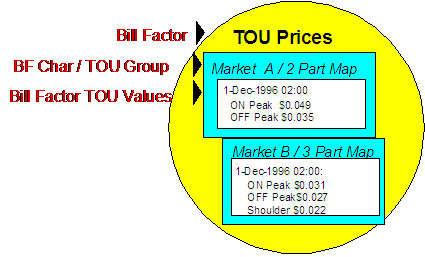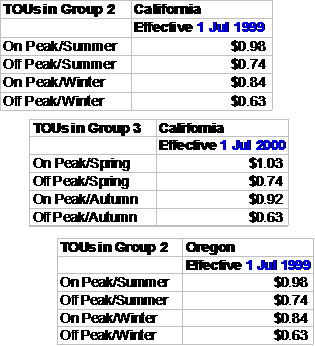Bill Factor TOU Values
A bill factor may also contain values, which differ by a TOU code. This enables you to set up prices that differ by TOU or to set up contract values, which differ by TOU.

Bill Factor TOU values are typically used to record prices, which vary by time of use code. TOU prices are used in conjunction with time of use mapping. The customer would typically have interval quantities, which are mapped, using a TOU Map, into a collection of time of use quantities. Defining a bill factor with prices per TOU allows you to set up a single rate component to apply charges to these quantities, resulting in multiple bill calculation lines.
Similar to simple bill factors, TOU bill factors may have characteristics defined. In the above example, the characteristic is the "Market" where the prices are defined. This bill factor probably indicates that the Service Agreement has a characteristic indicating the market from which it gets its prices. This enables you to use a common rate for customers who get their prices from different markets.
In addition to defining the characteristics, TOU bill factors must also indicate the TOU Group. The TOU group is a collection of time period definitions, which make up a TOU map. This enables you to define different prices for On Peak, when it is part of a two-part TOU map versus when it is part of a three-part TOU map.
Refer to Grouping of TOU Codes for more information.
The TOU prices are defined for the combination of characteristic and TOU Group. In the examples below, a bill factor's characteristic is State. Also note that the effective date of the prices are the same for all time of use codes. If the price of any TOU value changes, then a new set of prices for all TOU codes must be entered.

The application of these time of use values requires the use of an algorithm. If your business uses the interval billing subsystem and uses time of use mapping and pricing, then functionality is available for applying these values to interval quantities, which have been mapped into time of use quantities. Refer to The Big Picture of Interval Billing for more information.
